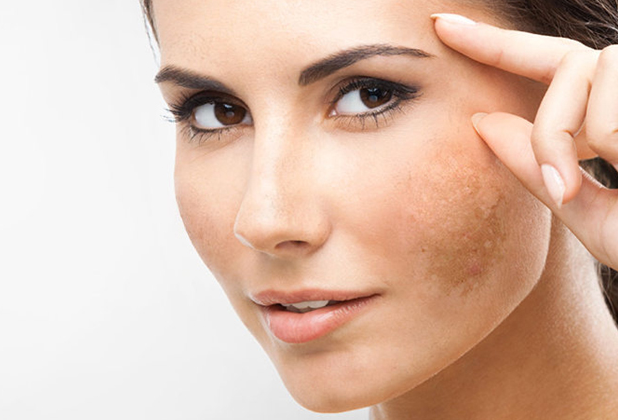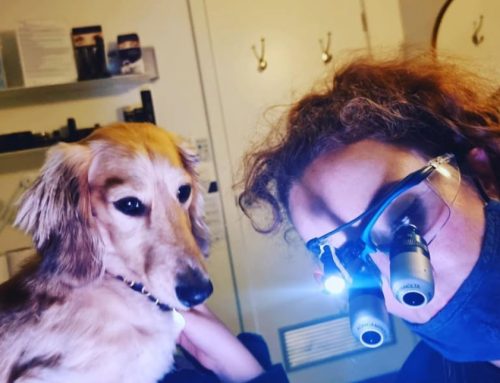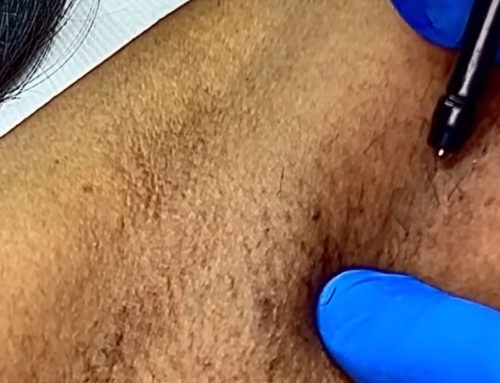For those of you unfamiliar with the term melasma, this refers to a chronic skin pigmentation condition. It is usually identified by block pigmentation (rather than irregular freckling), appearing in a symmetrical/mirror image pattern on the face, much like a butterfly. It’s this unusual pattern that earns itself the nickname ‘the mask of pregnancy’. That being said, melasma can take up residence on other parts of your face, including the forehead, cheeks, upper lip and jawline.
Melasma Myth – You cannot treat melasma
This is actually more complex than many of us realise, in short, you can treat melasma however we must learn to manage our expectations. This is due to a number of reasons, including:
- Location of melasma (dermal vs epidermal)
- Cause of melasma
- Treatment modality used
While we can physically treat the skin condition, it is unlikely that the pigment is completely and permanently removed. Allow MM to expand on the above points.
Location – melasma can reside in different layers of our skin, including both the dermis and the epidermis. Any pigment within the dermis cannot be treated as it is now a permanent feature, whereas pigment within the epidermis can be treated and the outcome will depend on the other factors we will discuss. How do you know if you have epidermal or dermal melasma? In truth many people have a combination of both. Melasma present in the epidermis will have darker brown colour and a well-defined border whereas melasma within the dermis will appear light brown in colour (or even have a blueish tint) and it will have a less defined border, it can almost look distant within the skin.
Cause – melasma is often typecast to being pregnancy related, yet upon closer investigation the causes are vast. For many women it will first appear while they are pregnant hence the common conception. However, melasma can occur whenever there is overstimulation to the melanocyte cell, within this cell the melanosomes produce excess pigment and then deposit the pigment into neighbouring skin cells (keratinocytes) resulting in dark brown patches of skin. Factors that can cause melasma or stimulate the melanoctyes into overdrive include:
- Genetic predisposition (certain ethnicities are more prone)
- Sun exposure
- Hormonal changes (pregnancy)
- Some medications
- Some hormonal contraceptives
- Hypothyroidism
Treatment modality – it is true that certain treatments should not be used to treat melasma. These can include heat inducing treatments, as the heat itself can act as a catalyst for the melanin producing cells (melanocytes) forcing them into overdrive thereby increasing pigment production. Additionally, even suitable treatments performed prior to adequately prepping of the skin can be counterproductive for treatment of melasma
Melasma Myth – only women experience melasma
This is false, yes, melasma is more common in women but this doesn’t mean our male counterparts are not susceptible. Ethnicity will play a large role here, for example only 1 in 4 to 1 in 20 affected individuals are male (depending on the population studied).
Typically, melasma’s first onset will be between the ages of 20-40, with less common cases beginning in childhood or middle age.
Gender aside, melasma is more common in those who have the ability to tan well or whom naturally have olive skin (Fitzpatrick 3 and 4). Melasma is less common in those with fair skin or black skin. Ethnicities MM observes melasma in most frequently include: East Asian, Brazilian, Indian, Pakistani, Middle-Eastern, Hispanic and Mediterranean.
Melasma Myth – homecare products won’t help
For best results to manage melasma (help lighten) an integrated approach incorporating professional clinical treatments in conjunction with a 5 step homecare regime is ideal. One without the other may not yield the best possible result. Advances in technology now allow us the benefit of scientifically researched cosmedical grade ingredients that have the ability to create cellular change. The ingredients of most benefit to melasma sufferers are those collectively known as tyrosinase inhibitors. Their action works to inhibit an enzyme (tyrosine) within the melanosome of the melanocyte, thereby reducing melanin production. Examples of tyrosinase inhibiting ingredients include:
- Daisy flower (found in Skinstitut Even Blend Serum)
- Vitamin C (found in 100% purity in Skinstitut Vitamin C 100%)
- Licorice root (found in Skinstitut Multi-Active Mist)
- Litsea cubeba (citrus extract found in Skinstitut Multi-Active Oil)
Melasma Myth – you can’t do anything about melasma while pregnant
There is some truth to this myth, MM does not recommend treating melasma with clinical treatments while pregnant or breastfeeding, rather you’re best to wait until hormones settle down after this period to commence more intensive treatments. However, most homecare products can be used throughout this period, with the exception of high intensity vitamin A (like retinol). You’re best to opt for a gentler, botanically derived vitamin A that is safe to use while pregnant (like that found in Skinstitut Rejuvenate 15 Serum).
For anyone wishing to target melasma MM always recommends a skin consultation by a qualified skin specialist to discuss all professional treatment and homecare options suitable!
MM’s brightening lifestyle tips
Little things you do each day can help prevent the pigmentation from getting worse and also work hand in hand with your clinical treatments and homecare regime. Be sure to:
- Avoid excessive sun exposure and wear SPF
- Wear a hat and sunglasses whenever outdoors
- Increase intake of fresh fruit and vegetables to provide antioxidants, vitamins and minerals
- Reduce alcohol and processed food intake
- Avoid excessively high protein diets
- Be aware of missing nutrients if following a restricted diet for health reasons and seek appropriate professional advice
- Adopt relaxation methods to help control stress etc.
- Assess and re-evaluate make-up and skin care products
Thankyou to Skinstitut for this info on melasma! Come to Bare Bella for a free skin consult to discuss a multi faceted approach to minimizing your pigmentation with home care and Skin Needling and Ageless peel! Prepping is a must.







